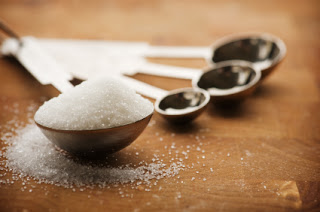Lately there has been a lot of “sweet” or maybe not so sweet news. There was a study from the Journal of the American Medical Association linking added sugar to heart disease, this week a correlation between chocolate and depression (which I found completely depressing) made headlines and now some interesting findings that agave is perhaps not the sweet savior many thought it to be.
While I read every study that comes my way, what I’m wondering is don’t we know this? Since when was sugar ever healthy? I recall growing up (pre MS or RD) knowing that sugar causes cavities and that too much sugar makes you gain weight. Later, working in a hospital setting, we always discussed sugar with patients when we saw their triglycerides were elevated (one of the findings of the recent study). Despite, years of knowing sugar isn’t a health food people are consuming more and more sugar. And what’s worse is that sugar is not really on our radar. Perhaps it’s a vestige of the 90s but many people monitor fat intake. Salt has received more attention lately but even before Bloomberg clients coming to my office had a sense that salt increases blood pressure and certainly females know salt increases bloat. Maybe fat and salt are easier to grasp.
We may be less sugar conscious because we associate sugar with diabetes or cavities and sadly these issues may be less scary or real. Yet sugar plays a role in arthritis and asthma, may intensify mood swings, PMS and depression and via insulin and inflammation can set the stage for cancer growth. This isn’t meant to alarm you (well maybe a little) but rather to shed light on sugar. American consume, on average, over 60 pounds of sugar annually. The JAMA study on heart disease and sugar gauged daily sugar intake at over 20 teaspoons of added sugars a day. I hope this sounds as appalling to you as it does to me.
So what are we to do? For starters, look at food labels and ingredient panels. On food labels you’ll see sugars listed in grams, there are about 4 grams to every teaspoon (12 grams of sugar would be 3 tsp). If you want a daily budget I would suggest 25 grams for women and 50 grams for men however I’m not a big fan of counting what we eat. On your ingredient lists, sugar can be sly. Some sugars end in “ose” such as dextrose, fructose and glucose. Others include the word syrup (corn, HFCS maple and rice) and then there is cane, honey and molasses. When you see any of these and sometimes you’ll see multiple sugar sources, that food has added sugar. Today, take inventory of your sweet foods. Coffee with sugar…check, yogurt with honey…check, sweet salad dressing- they add up quickly. See where you can cut down or cut out sweetness. If you can get down to 1 or 2 sweet items daily you’re doing pretty well.
With my clients, I have an exercise called a Savory Day where clients forego anything sweet 1 day a week. Try this and let me know how it goes, you may feel, as I do, that sweet begets sweet and the less you have the less you crave. I use dried fruit and minimal honey and maple syrup and have acclimated to unsweetened coffee though it took some time. Actually less sweetness led to less coffee too.
So how “sweet” are you? How many sweet items to do you consume? What sweeteners to you use?



definitely the less you eat the less you crave. at least in my case. i have a huge sweet tooth, but if i can forgo i feel better physically. dates and honey are my healthy sweets. i've been putting honey in my coffee in the morning – it takes the bite out….but why minimal honey? i don't know that what i put in my coffee could be considered minimal.
Since working your plan, I've almost completely lost the taste for sugar and sweet. Now that I'm 3 months in, I've found that I almost don't like sweet anymore. For my birthday weekend, I indulged myself w/ a burger (only half!) and fries (ok, all of them) but felt totally ok passing up sweets. Giving up the diet coke for unsweetened green tea made a huge difference, too. My nightly square of dark dark chocolate and fruit are the only sweet flavors I crave anymore. But I will cut someone who tries to separate me from my mango!
The savory day is a great exercise and an easy one to keep the sweet tooth in check. It's a very interesting point too that its seems learning the evils of sugar is one of the first eating lessons most of us got as kids, why now is it news?
Good comments! DR- I said "minimal" because honey, maple syrup and all more natural sweeteners are still forms of sugar to be limited. Marie, mangos are here to stay, I will never risk separating you from yours. And regarding the lesson we learn first and forget-I think people don't know how to watch or limit sugar without eliminating it and therefore really don't consider it and the risks of consuming it in excess.
I love this post! Too much sugar is definitely one of the reasons for a bunch of diseases!! I always try to get plain or unsweetened anything when I can and try to just consume sugars in fruits only. After cutting it back a lot I found I didn't really crave or want it anymore 🙂
Thanks for the great comment on my blog! Sometimes I do need a recipe too – new ingredients, or technique especially. Once I've made something I just throw some of this and some of that in! 🙂 Smoothies and juice are always just whatever's on hand and what I feel like 🙂